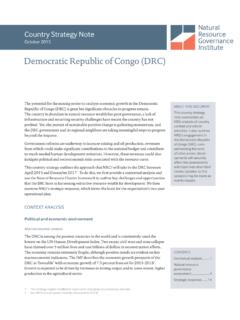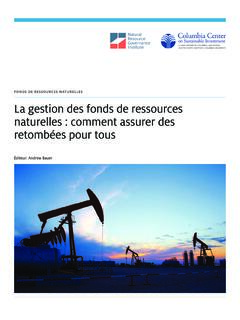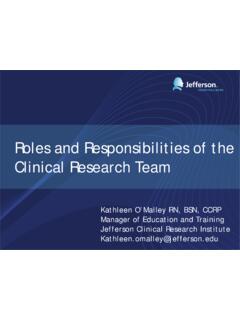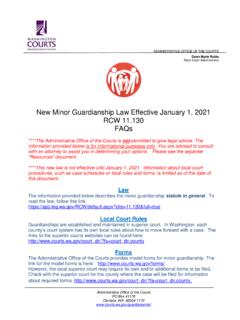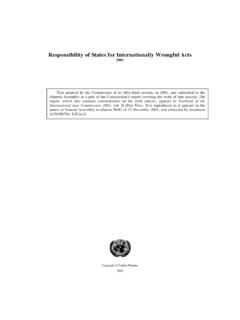Transcription of NRGI Reader - Natural Resource Governance Institute
1 legal FrameworkNavigating the Web of Laws and Contracts Governing Extractive IndustriesNRGI ReaderMarch 2015 The rules, responsibilities and institutions governing the behavior of actors are central to optimal Resource management. Natural Resource Charter, Precept 1 This Reader is intended for use in conjunction with Precepts 1, 3 and 4 of the Natural Resource MESSAGES The rules, rights and obligations of companies, governments, and citizens are set forth in a system of legal documents called a legal framework. Documents in the legal framework include a country s constitution, legislation, policy, regulations and contracts. Laws and policy are supposed to have more authority than a contract.
2 However, contracts can also be written to explicitly override the laws and regulations. legal documents that cover broad principles, like constitutions, are generally more difficult to change. More specific documents, like laws and contracts, can often be more easily amended. Countries with detailed laws and policies often have more stable and predictable legal frameworks than those that leave more aspects open for negotiation in individual contracts. In some countries, national courts resolve scenarios where legal documents conflict or parties have different interpretations about what the documents mean. However, extractive industry contracts often stipulate that any disagreement go to international arbitration.
3 legal FRAMEWORKFor each project to extract Natural resources from the ground, there are rules that govern the rights and responsibilities of governments, companies, and citizens. Together these rules are called a legal framework, or legal architecture. Who is involved in making these rules and what documents they use to define them differs from country to country. The legal framework that governs the extractive industries rests inside a broader set of rules governing the organization of the state and economic activities. A well-designed legal architecture should provide rules for how state institutions are structured; how companies acquire and manage licenses; the fiscal terms governing payments between companies and the state; environmental management; relationships between extractive projects and neighboring communities; the behavior of public officials active in the sector; public information disclosure and accountability; and how the government 2 legal Frameworkwill manage Natural Resource revenues.
4 When companies begin to engage in a country, they must check that they are in compliance, or following, all of the rules in the legal framework of a country. legal frameworks comprise a set of documents that include the constitution, legislation, regulations, and contracts. How these documents relate to one another, which has more force than the other, is often referred to as a legal hierarchy, as illustrated in the pyramid below. Moving from the bottom of the pyramid to the top, each instrument becomes increasingly detailed or specific. Each instrument on the pyramid should be consistent with the instruments below it. In a properly ordered legal hierarchy, a country would not agree to terms in a contract that conflict with rules established in regulation, legislation or the constitution.
5 Also, laws and policy are supposed to have more authority than a contract take precedence, in legal speak. In practice, however, contracts can also be written to explicitly override the laws and A constitution establishes the basic structure of government and the rights and responsibilities of citizens. It reigns supreme over all other legal instruments in a country. As foundational documents, constitutions are purposefully difficult to modify, with changes frequently requiring some sort of super-majority approval in the legislature or popular referendum. Many constitutions include information relevant to Natural resources, such as the structure of political institutions, checks and balances within the political system, rights to land ownership, environmental protection, civil legal process, and labor standards.
6 Fundamental values concerning Natural Resource Governance , including national ownership of subsoil resources and a commitment by the state to manage these resources in the public interest, are included in some constitutions in Resource -rich countries. Most constitutions do not establish specific rules governing the sector. A few countries have included specific provisions on key policy issues, including formulas for Resource revenue-sharing ( , Nigeria, South Sudan); requirements that parliament approve contracts (Kuwait, Ghana, Tunisia) or that all contracts be made public (Mexico, Niger). Figure 1. The legal Hierarchy Source: NRGI ContractsRegulation/Rules/ Model ContractPolicy/LegislationConstitution3 legal FrameworkPolicy and legislation.
7 National policies and laws should provide a coherent set of strategies and rules to govern behavior in the sector. Many countries draft formal petroleum or mineral sector policies to define a core set of principles and goals that will underpin all other rules and activities. Some policies are approved by a national legislature, while others are promulgated by the executive alone. The best-designed policies are developed through a process of broad-based consultation that incorporates stakeholder feedback and provides a clear explanation of public is the legally binding set of rules that govern the vision established in a policy. Most Resource -rich countries have laws that focus on elements of the oil and/or mining sector ( , mining code, petroleum exploration and production act, among others).
8 In addition, more general laws often represent a major component of the rules for the industry, including environmental laws, labor laws, tax laws, and land management laws. In democracies, legislation is usually created by a process requiring action by the legislative and the executive branches of government, which means that changing the rules embodied in legislation also requires legislative and model contracts. Regulations are usually the implementing rules created by an executive body of government to make legislation practical. They are most often tied to a law but provide significantly more detail. For example, a law may require that the executive awards petroleum licenses by competitive tender and spell out the general parameters governing the tender process.
9 The regulation implementing this legislation may then describe how, when and where interested companies must register their interest and the specific forms they must submit. Often the legislation will give some guidelines about what the regulations should cover. The method of passing regulations varies from one country to another, but in many instances a branch of the executive (such as a ministry, or the cabinet acting as a whole) has the power to create regulations without seeking legislative approval. A model contract provides a template for agreements between the government and extractive companies. Some countries have very detailed model contracts, with one or several sections left blank to account for the results of a tender process, or to be completed during negotiation.
10 In other cases, the model contract serves as a starting point and more substantial variation is allowed as a part of individual negotiations. By using model contracts, states can reduce the need for lengthy negotiations and increase their leverage by fixing some of the parameters that would otherwise be up for negotiation. Some governments have formalized their use of a model contract by establishing it as a regulation or appending it to legislation. In other countries, the model is more of a guiding document created by the government or state-owned enterprise(s) responsible for licensing or contract negotiation. By using model contracts, states can reduce the need for lengthy negotiations and increase their leverage by fixing some of the parameters that would otherwise be up for negotiation.
